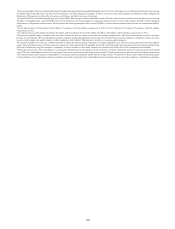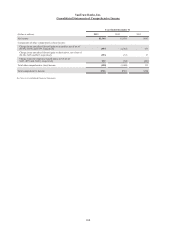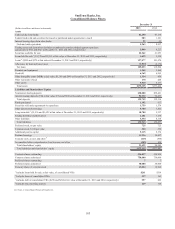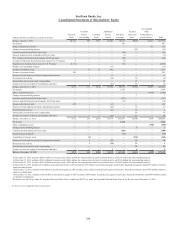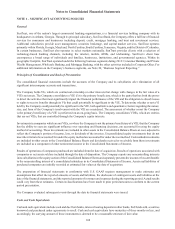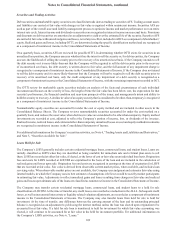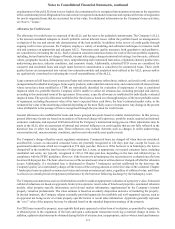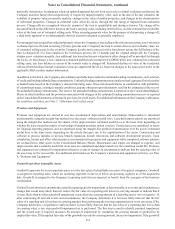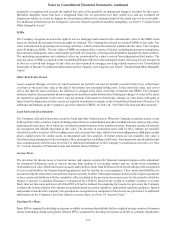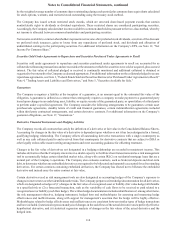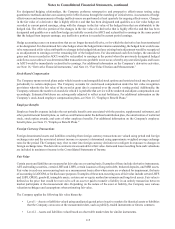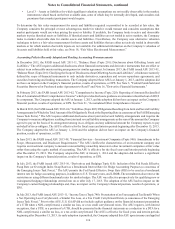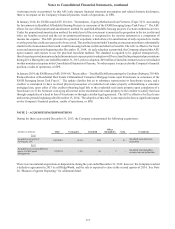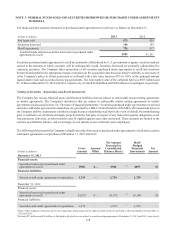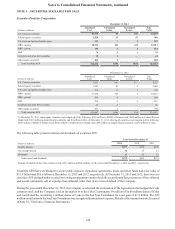SunTrust 2013 Annual Report Download - page 126
Download and view the complete annual report
Please find page 126 of the 2013 SunTrust annual report below. You can navigate through the pages in the report by either clicking on the pages listed below, or by using the keyword search tool below to find specific information within the annual report.Notes to Consolidated Financial Statements, continued
110
Loans
Loans that management has the intent and ability to hold for the foreseeable future or until maturity or pay-off are considered
LHFI. The Company’s loan balance is comprised of loans held in portfolio, including commercial loans, consumer loans, and
residential loans. Interest income on all types of loans, except those classified as nonaccrual, is accrued based upon the
outstanding principal amounts using the effective yield method.
Commercial loans (commercial & industrial, commercial real estate, and commercial construction) are considered to be past
due when payment is not received from the borrower by the contractually specified due date. The Company typically classifies
commercial loans as nonaccrual when one of the following events occurs: (i) interest or principal has been past due 90 days
or more, unless the loan is both well secured and in the process of collection; (ii) collection of recorded interest or principal
is not anticipated; or (iii) income for the loan is recognized on a cash basis due to the deterioration in the financial condition
of the debtor. When a loan is placed on nonaccrual, unpaid interest is reversed against interest income. Interest income on
nonaccrual loans, if recognized, is recognized after the principal has been reduced to zero. If and when commercial borrowers
demonstrate the ability to repay a loan in accordance with the contractual terms of a loan classified as nonaccrual, the loan
may be returned to accrual status upon meeting all regulatory, accounting, and internal policy requirements.
Consumer loans (guaranteed and private student loans, other direct, indirect, and credit card) are considered to be past due
when payment is not received from the borrower by the contractually specified due date. Guaranteed student loans continue
to accrue interest regardless of delinquency status because collection of principal and interest is reasonably assured. Other
direct and indirect loans are typically placed on nonaccrual when payments have been past due for 90 days or more except
when the borrower has declared bankruptcy, in which case, they are moved to nonaccrual status once they become 60 days
past due. When a loan is placed on nonaccrual, unpaid interest is reversed against interest income. Interest income on nonaccrual
loans, if recognized, is recognized on a cash basis. Nonaccrual consumer loans are typically returned to accrual status once
they are no longer past due.
Residential loans (guaranteed and nonguaranteed residential mortgages, home equity products, and residential construction)
are considered to be past due when a monthly payment is due and unpaid for one month. Guaranteed residential mortgages
continue to accrue interest regardless of delinquency status because collection of principal and interest is reasonably assured.
Nonguaranteed residential mortgages and residential construction loans are generally placed on nonaccrual when three
payments are past due. Home equity products are generally placed on nonaccrual when payments are 90 days past due. The
exceptions for nonguaranteed residential mortgages, residential construction loans, and home equity products are: (i) when
the borrower has declared bankruptcy, in which case, they are moved to nonaccrual status once they become 60 days past due;
(ii) loans discharged in Chapter 7 bankruptcy that have not been reaffirmed by the borrower, in which case, they are moved
to nonaccrual status immediately; and (iii) second lien loans which are classified as nonaccrual when the first lien loan is
classified as nonaccrual even if the second lien loan is performing. When a loan is placed on nonaccrual, unpaid interest is
reversed against interest income. Interest income on nonaccrual loans, if recognized, is recognized on a cash basis. Nonaccrual
residential loans are typically returned to accrual status once they no longer meet the delinquency threshold that resulted in
them initially being moved to nonaccrual status, with the exception of the aforementioned Chapter 7 bankruptcy loans, which
remain on nonaccrual until there is six months of payment performance following discharge by the bankruptcy court.
TDRs are loans in which the borrower is experiencing financial difficulty at the time of restructure and the borrower received
an economic concession either from the Company or as the product of a bankruptcy court order. To date, the Company’s TDRs
have been predominantly first and second lien residential mortgages and home equity lines of credit. Prior to granting a
modification of a borrower’s loan terms, the Company performs an evaluation of the borrower’s financial condition and ability
to service under the potential modified loan terms. The types of concessions generally granted are extensions of the loan
maturity date and/or reductions in the original contractual interest rate. Typically, if a loan is accruing interest at the time of
modification, the loan remains on accrual status and is subject to the Company’s charge-off and nonaccrual policies. See the
“Allowance for Credit Losses” section below for further information regarding these policies. If a loan is on nonaccrual before
it is determined to be a TDR then the loan remains on nonaccrual. Typically, TDRs may be returned to accrual status if there
has been at least a six month sustained period of repayment performance by the borrower. Generally, once a residential loan
becomes a TDR, the Company expects that the loan will continue to be reported as a TDR for its remaining life even after
returning to accruing status unless the modified rates and terms at the time of modification were available in the market.
Interest income recognition on impaired loans is dependent upon nonaccrual status, TDR designation, and loan type as discussed
above.
For loans accounted for at amortized cost, fees and incremental direct costs associated with the loan origination and pricing
process, as well as premiums and discounts, are deferred and amortized as level yield adjustments over the respective loan
terms. Fees received for providing loan commitments that result in funded loans are recognized over the term of the loan as


